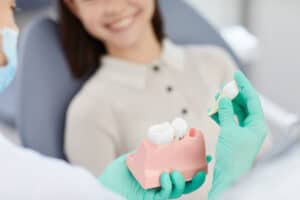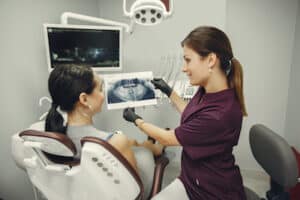
06 Feb Do I Have to Replace My Extracted Tooth?
Do I Have to Replace My Extracted Tooth?
Your dental hygiene is incredibly important for creating and maintaining a healthy, beautiful smile and sometimes a tooth extraction can be a necessary part of developing and improving the health of your teeth. There are reasons why some teeth must be pulled, such as when there is extensive tooth decay or damage that can no longer be repaired through restorative treatments like a filling or crown. So, if you’ve recently had a tooth extracted and you are wondering, do I have to replace my extracted tooth?
It depends on the case, as in some you may or may not have to replace the tooth. Several factors that this depends on include the location of the missing tooth, its function in your mouth, and your desired cosmetic outcome you may find that it is more beneficial to have the tooth replaced.
In this blog post, we’ll cover the process of a tooth extraction, the factors that can help you decide whether or not a replacement is a route you want to go down, and the options for restoring your smile after a dental extraction! So, keep reading on to learn more!

Tooth Extraction
There are several reasons why you might need to get a tooth extracted. The most common reason is that the tooth is impacted, meaning it has become stuck in the jawbone or soft tissue and cannot erupt normally. Other causes of needing an extraction could be severe decay, advanced periodontal disease, overcrowding, or trauma to the mouth. In some cases, your dentist may recommend taking out a baby tooth if it’s preventing adult teeth from coming in properly.
The process for getting a tooth extraction can vary depending on the individual situation and the type of tooth being removed. Generally speaking, before any procedure your dentist will first evaluate your overall oral health condition and take X-rays of the affected area. This helps them determine the best approach for the extraction.
The extraction procedure itself is usually done using a local anesthetic to minimize any discomfort, but sedation may be offered in certain cases. After the tooth has been removed, your dentist will provide instructions on how to care for and manage your recovery. This typically involves eating soft foods and keeping the area clean with warm salt water rinses until it heals completely. Following these instructions carefully will help you heal properly and prevent infection or other complications.
In most cases, tooth extraction can effectively resolve many dental issues that cannot be fixed by other treatments such as fillings or root canals. While this procedure can sometimes seem daunting, it’s important to remember that tooth extractions are relatively straightforward procedures and they can help improve your oral health in the long run. If you have any questions or concerns about needing a tooth extraction, it’s best to consult with your dentist for more information.
Does Having a Tooth Extracted Hurt?
Having a tooth extracted can cause some discomfort, but most patients report that it is not overly painful. During the procedure, your dentist or oral surgeon will give you a local anesthetic to numb the area around the tooth. This should make the extraction process relatively painless and help reduce any potential discomfort afterward. Your dentist may also use general anesthesia if necessary for more complicated extractions.
Afterward, there may be some soreness in the area where the tooth was removed and you may experience swelling or bruising of your gums. To help manage this discomfort, your dentist will likely prescribe antibiotics and analgesics (painkillers) such as ibuprofen to alleviate symptoms and prevent infection. Your dentist may even suggest using ice packs and saltwater rinses to help reduce swelling and pain.
It is important to follow any instructions provided by your dentist after the extraction procedure so that healing can take place properly and without complications. Taking care of yourself in the days following a tooth extraction will also make the process more comfortable overall.
In general, having a tooth extracted should not be overly painful for most patients. With proper care and attention, you should be able to recover quickly from the procedure with minimal discomfort. Contact your dentist if you have any questions or concerns about what to expect during or after extraction.

Replacing an Extracted Tooth
Replacing an extracted tooth is a personal decision that should be made after careful consideration. Depending on the location of the missing tooth and its function in your mouth, you may find that it is more beneficial to have the tooth replaced. If the extracted tooth was in a prominent location, such as in the front or at the side of your mouth, replacing it can help restore symmetry to your smile and improve facial aesthetics. Additionally, if the missing tooth affects your ability to chew food properly or speak clearly, replacing it may help these issues as well.
On the other hand, replacement may not be necessary if you are comfortable with how everything looks and functions without it. Ultimately, this decision will depend on both your own preferences and dental advice. Your dentist can examine the area and discuss with you what tooth replacement option would be best for your individual case.
Therefore, it is important to talk to your dentist about whether or not replacing an extracted tooth is necessary in order to make an informed decision. With their help, you can determine which solution will be best for restoring form and function to your mouth.
The Different Ways to Replace an Extracted Tooth
Replacing an extracted tooth is a common and relatively straightforward procedure that can be done to help restore the smile and dental functionality of a patient. An extraction may occur due to trauma, infection, or other issues with the teeth. In many cases, these extracted teeth can be replaced with either a bridge or an implant.
A bridge is generally used when there are fewer than three missing teeth in one area of the mouth. The bridge consists of two crowns on either side of the gap created by the missing tooth, which holds in place a replacement tooth. Bridges can improve function for eating and speak, as well as maintaining proper spacing between adjacent teeth.
On the other hand, if more than three consecutive teeth are missing, a dental implant may be a suitable option. Unlike bridges, implants are secured into the jawbone in place of the extracted tooth. This ensures stability and helps to prevent bone loss in the area around the missing tooth. Implants also look and function like natural teeth and can last for many years with proper care and maintenance.
Overall, replacing an extracted tooth can help restore oral health, dental functionality, and confidence in one’s smile. It is important to discuss all available options with your dentist so that you can make an informed decision about which treatment will best suit your individual needs. With either a bridge or an implant, patients can enjoy improved aesthetics and renewed confidence in their smiles!

Finding the Right Cosmetic Dentist
Finding a cosmetic dentist can be a daunting task, but it doesn’t have to be. Start by asking family and friends for recommendations. People who have had successful treatments or know someone who has can provide valuable information about the quality of care provided by certain dentists in your area. You should also look for reviews on websites like Google and Yelp, as these can give you an idea of what other patients think about the practice.
Another way to find out more about a cosmetic dentist is to ask their existing patients questions about the procedures they had done, and whether or not they were pleased with the results. Additionally, you may wish to contact any dental associations in your state for referrals, or even search through local classifieds and advertisements.
Once you have a few potential dentists in mind, it’s important to check their credentials and experience. All cosmetic dentists should be registered with the American Dental Association (ADA). You can also find out about their background by looking at websites such as the Academy of Cosmetic Dentistry or the American Academy of Cosmetic Dentistry. These websites may provide information on board certifications, specializations, educational backgrounds, and more.
Finally, when meeting with a prospective cosmetic dentist, make sure that you ask plenty of questions. Ask them how they plan to perform the treatment, any risks associated with the procedure, what type of follow-up care will be provided afterward, and anything else that is important to you. Taking the time to do your research and ask questions will help ensure that you get the best possible care.
Conclusion
When you have chosen a cosmetic dentist, be sure to keep up with regular checkups and follow-up appointments. After any procedure, it is important to monitor how your mouth feels and look for signs of infection or other complications. If there are any concerns, contact your dental team right away so they can provide the necessary care. With the right preparation, finding a qualified and experienced cosmetic dentist shouldn’t be difficult. Good luck!


Sorry, the comment form is closed at this time.